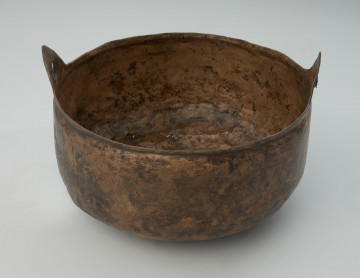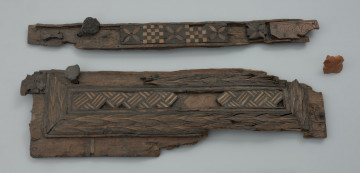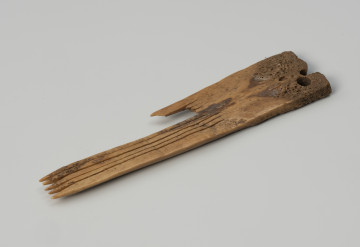
Boiler
601 — 1000
National Museum in Szczecin
Part of the collection: Middle Ages
A copper alloy colander discovered during underwater archaeological excavations carried out in 1952 by Władysław Filipowiak in Wolin, Kamień district. It was excavated from river silt at a depth of 9.52 metres during water engineering works. In addition to the colander, two cauldrons, also made of copper alloy, were also found at the time. The colander was made by flattening a sheet of metal and forming it into a designed shape. It also has two triangular handles with a height of 2.8 centimetres with holes. The inner surface bears numerous marks resulting from forming the shape of the vessel, made by a blunt tool. One can also see the traces of repairs – patches on cracks and holes. Any damage would be repaired with pieces of sheet metal, which were applied from one or both sides, depending on the scope of the damage. An 8 × 5 cm patch of sheet metal was used to repair the biggest damage, affixed to the artefact with 12 small rivets. The bottom of the colander has numerous holes about 0.3 centimetre in diameter. The object was probably made from a damaged cauldron, which no longer fulfilled its original function as a result of numerous repairs.
Grzegorz Durdyń
Author / creator
Dimensions
cały obiekt: height: 11.2 cm
Object type
colander, kitchenware
Technique
peening
Material
copper alloy
Origin / acquisition method
field research
Creation time / dating
Creation / finding place
Owner
Muzeum Narodowe w Szczecinie
Identification number
Location / status

601 — 1000
National Museum in Szczecin

1176 — 1200
National Museum in Szczecin

1176 — 1200
National Museum in Szczecin
DISCOVER this TOPIC
Museum of King Jan III's Palace at Wilanów
DISCOVER this PATH
Educational path